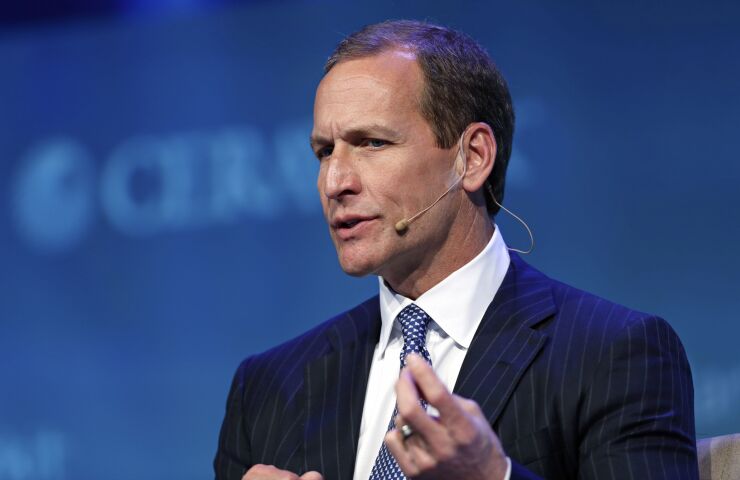A large majority of secured creditors, including stakeholders of a $1.5 billion first-lien term leveraged loan issued in December, have pledged support for the proposed voluntary restructuring plan filed by Chesapeake Energy Corp. (NYSE: CHK) in federal bankruptcy court.
About 87% of secured creditors have given their approval for the Chapter 11 plan filed by the Oklahoma City-based company filed in U.S. Bankruptcy Court in the Southern District of Texas on Sunday.
Chesapeake listed assets and liabilities in the range of $10 billion and $50 billion, and more than 100,000 creditors, according to the filing. The company has approximately $3.8 billion in secured debt, a $3 billion revolving credit facility, and $2.3 billion in unsecured note obligations, according to various ratings agency reports.
In a report Monday, fixed income research firm KDP Advisors noted that term loan creditors would receive a 76% pro rata share of the common shares in the reorganized company, as well as participation in future rights offerings.
Among the secured debts is a $1.5 billion term loan due June 2024 that Chesapeake issued last December to repay debt of its Brazos Valley Longhorn LLC subsidiary. Portions of the the loan were broadly syndicated to more than 40 collateralized loan obligations vehicles as of April, according to the CLO database of data analytics and research firm Trepp.
The loan has been trading below par at 60 cents on the dollar (per KDP) in the secondary loan market, and was recently downgraded by Moody's Investors Service and S&P Global Ratings.
Moody's downgrade on April 24 lowered the term loan's rating to Caa1 from B3, noting the firm's "eroding liquidity, the prospect of significant production declines due to substantially reduced capital investment, a depressed commodity price environment, very limited access to capital, and the high likelihood of a restructuring in the near term."
Last week, S&P Global Ratings downgraded the facility to a default rating after Chesapeake missed $10 million in interest payments due on two series of unsecured notes. (S&P lowered both Chesapeake's issuer rating as well as its unsecured and secured debt ratings as a result of the skipped payments).
Holders of the company’s revolving credit revolver gave 100% approval of the plan, which would provide a dollar-for-dollar recovery of their share of the company’s outstanding exit facility loans. The company had $1 billion available in the facility at year-end 2019, but Moody's stated in an Aprilreport it was highly likely the availability would be reduced after a semi-annual lenders redetermination review of the company's borrowing base.
Unsecured noteholders of approximately $2.3 billion in bonds would gain a 12% share of new common stock shares; less than 60% signed on to Chesapeake’s Chapter 11 plan, according to KDP and court documents.
As part of its bankruptcy, Chesapeake secured a $925 million debtor-in-possession loan to support ongoing operations as well as two new debt facilities upon exit from bankruptcy proceedings: a $1.75 billion revolver and a $750 million term loan.
The plan would eliminate roughly $7 billion in debt.
Spectacular collapse
Chesapeake, the archetype for America’s extraordinary shale-gas fortunes, goes down as one of the biggest victims of a spectacular collapse in energy demand from the virus-induced global lockdown.
“We are fundamentally resetting Chesapeake’s capital structure and business to address our legacy financial weaknesses and capitalize on our substantial operational strengths,” Chief Executive Officer Doug Lawler said in a statement.

Chesapeake is, to a certain extent, victim of the success both it and its peers had in extracting huge volumes of gas from previously hard-to-exploit shale basins. While that turned the U.S. into a global supplier of the fuel to rival any other, it also contributed to a glut that weighed on prices. Natural-gas futures in New York traded last week at a 25-year low.
But the gas market is only part of the story. Earlier in its history, under the direction of its late co-founder Aubrey McClendon, a colorful and outspoken advocate for the natural gas industry, Chesapeake expanded aggressively. The heavy debt load it acquired in the process was a burden it ultimately couldn’t shake off.
About a decade ago, Chesapeake was a $37.5 billion giant at the forefront of the fracking revolution that transformed the U.S. oil and gas industry. The company cut eye-popping checks to Fort Worth businesses and residents as inducements to drill on their land in the Barnett Shale of North Texas, America’s first shale field to hit the big time.
U.S. natural gas slumped after the 2008 financial crisis as the frackers overwhelmed demand, and prices still haven’t revisited their previous highs. Investors soured on Chesapeake, which by that point wasn’t only debt-laden but saddled with a real estate empire that included shopping centers, a church, and a grocery store. McClendon was ousted in 2013 and died in an auto accident three years later.
In subsequent years, management sought to compensate for the decline in its gas fortunes by shifting into oil exploration as fracking turned the U.S. into the world’s largest producer of crude as well as a major exporter. However, any optimism about that strategy evaporated with oil’s recent price collapse amid the Covid-19 pandemic.
Despite the company’s efforts over the years to address leverage and profitability, “the recent and dramatic drop in commodity prices and resulting tightening of the credit markets have frustrated the Debtors’ ability to further deleverage absent a chapter 11 proceeding,” Chief Financial Officer Domenic J. Dell’Osso said in a declaration in support of the bankruptcy filings.
Lawler took over Chesapeake in 2013 with an aim of reducing its debt load that was larger than Exxon Mobil Corp.’s, a company 29 times Chesapeake’s market value at the time. He had counted on capital spending cuts and asset sales to cover debt obligations. The company was in talks last year with Jerry Jones, the billionaire Dallas Cowboys owner, about a $1 billion sale of shale assets, but no deal resulted.
In May, Lawler was forced to discard his company’s full-year outlook and write down the value of $8.5 billion in assets as energy demand tumbled amid the Covid-19 lockdown. By then, the producer’s market value had dropped to less than $200 million. The company had about 2,300 employees at the end of last year.
“Despite having removed over $20 billion of leverage and financial commitments, we believe this restructuring is necessary for the long-term success and value creation of the business,” Lawler said Sunday.
Chesapeake shares were halted during early trading Monday.
The bankruptcy follows that of another highflier in the U.S. oil patch, Whiting Petroleum Corp., which filed for Chapter 11 at the start of April after championing what was once the premiere U.S. shale field, the Bakken of North Dakota.
(This story includes reporting from Bloomberg).





